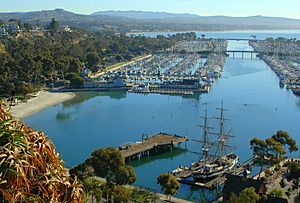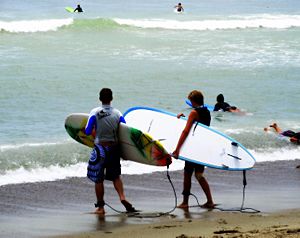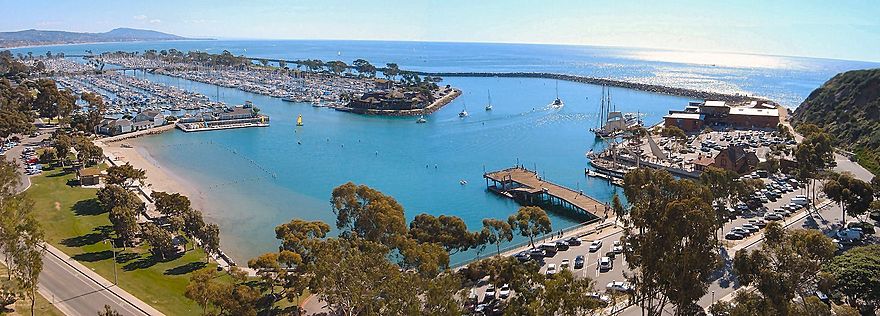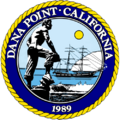Dana Point, California facts for kids
Quick facts for kids
Dana Point, California
|
|||
|---|---|---|---|
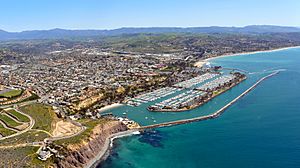
Aerial view of Dana Point
|
|||
|
|||
| Motto(s):
"Harboring the Good Life"
|
|||
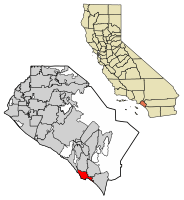
Location of Dana Point in Orange County, California
|
|||
| Country | |||
| State | |||
| County | |||
| Incorporated | January 1, 1989 | ||
| Named for | Richard Henry Dana Jr. | ||
| Government | |||
| • Type | Council-Manager | ||
| Area | |||
| • Total | 29.5 sq mi (76.40 km2) | ||
| • Land | 6.49 sq mi (16.80 km2) | ||
| • Water | 23.0 sq mi (59.57 km2) 77.96% | ||
| Elevation | 144 ft (44 m) | ||
| Population
(2020)
|
|||
| • Total | 33,107 | ||
| • Density | 5,102.81/sq mi (1,970.18/km2) | ||
| Time zone | UTC−8 (Pacific) | ||
| • Summer (DST) | UTC−7 (PDT) | ||
| ZIP Codes |
92624, 92629
|
||
| Area code(s) | 949 | ||
| FIPS code | 06-17946 | ||
| GNIS feature IDs | 1656474, 2410293 | ||
| Reference #: | 189 | ||
Dana Point is a city in southern Orange County, California, United States. In 2020, about 33,107 people lived there. It's known for having one of the few harbors along the Orange County coast. It's also a popular spot for surfing because it's easy to reach from State Route 1.
The city gets its name from the Dana Point headland, a piece of land sticking out into the ocean. This headland was named after Richard Henry Dana Jr.. He was an author who wrote a book called Two Years Before the Mast. In his book, he described the area, including nearby San Juan Capistrano, as "the only romantic spot on the coast." This special area is now a California Historical Landmark called #189.
Contents
History of Dana Point
Early People and European Arrival
The Acjachemen people lived in this area long ago. One of their villages, called Toovannga, was located close to where Dana Point Harbor is today. This village was near the mouth of the San Juan Creek. The Acjachemen people lived in villages of about 250 people and took good care of the land, making it a healthy place for plants and animals. Each village was independent and formed connections with other villages through marriage. The Dana Point area was downstream from their main village, Putuidem.
European settlers first arrived in the area with the Portolá expedition in 1769-1770. Starting in 1776, people from the village of Ubange, near Dana Point, were brought to Mission San Juan Capistrano. They were asked to adopt new beliefs and work on the mission's land.
Mexican Era and Trade
During the Mexican era, Dana Point was a busy port for ships involved in the California hide trade. This trade involved exchanging animal hides with nearby Mission San Juan Capistrano. This trading was most active in the 1830s and 1840s. In 1818, an Argentine sailor named Hippolyte de Bouchard anchored here during his attack on the mission. Later, in 1835, Richard Henry Dana Jr. visited the area while sailing on his ship, the Pilgrim.
American Era and Development
In 1923, Harry Chandler, who published the Los Angeles Times newspaper, and General M. H. Sherman, who directed the Pacific Electric Railway Company, started a big real estate group. Their goal was to develop the Hollywood Hills. They hired Sidney H. Woodruff, a well-known homebuilder from Los Angeles, to lead the project.
In 1926, Woodruff, Chandler, and Sherman formed the Dana Point Syndicate. They invited other investors, business leaders, movie producers, and real estate investors to join them. Together, they bought about 1,388 acres (5.6 km²) of land, which included parts of what is now called the "Headlands." Woodruff promised to build a modern community with tree-lined streets, paved roads, electricity, telephones, sidewalks, and water systems. He built 35 homes and several commercial buildings.
Most of these "Woodruff" houses are in the historic center of Dana Point, known as Lantern Village. The streets there are named after different colored lanterns, like Street of the Violet Lantern or Blue Lantern. This is because 200 years ago, ships used colored lanterns to show what they were selling when they were in Dana Point's natural harbor. Woodruff's biggest project was supposed to be the Dana Point Inn, a large hotel on the cliffs overlooking the harbor. Construction began in 1930, and a three-story foundation was poured. They even dug a 135-foot (41 m) shaft for an elevator to take hotel guests to the beach. However, the Great Depression caused money problems, and construction stopped. Woodruff tried to get more money for years, but the project was finally given up in 1939. He then sold the remaining land. Today, 34 of the original Woodruff homes are still standing.
Dana Point Harbor
The Dana Point Harbor was built in the 1960s and officially opened on July 31, 1971. It has a marina for boats, shops, and restaurants. It's also where the Catalina Express leaves from, taking people to and from Avalon on Catalina Island. The entire harbor area, including the shops and restaurants, is currently being updated and redeveloped.
Even though Richard Henry Dana Jr. said the harbor was not a good place for ships, it is now a well-developed harbor. It used to have a replica of his ship, the Pilgrim. The Pilgrim was used as a classroom by the Ocean Institute until it sank in 2020.
The Strands Area
The Strands at Headlands is a fancy housing development built on land that once belonged to the Chandler Family. For many years, the land facing the beach was home to the Dana Strand Beach and Tennis Club, a community of mobile homes that closed in the late 1980s. For a long time, getting to Strands beach meant hiking down a dirt path where the mobile homes used to be. The Strands area also included the actual headlands and cliffs of Dana Point. It was one of the last big pieces of land available for building along the Orange County Coast.
Over ten years of planning, the original idea for many buildings, including a large hotel on the cliff and hundreds of homes, was changed. It was reduced to just over 100 home sites. As part of talks with the California Coastal Commission, the builders agreed to turn the cliff into a nature preserve. They also agreed to spend over $11 million on public improvements to make it easier to get to Strands Beach. These improvements include stairs, restrooms, a sidewalk along the beach, and a funicular (a type of cable car) to take visitors from the parking lot to the beach. After a lot of building work, lots for homes were offered for sale in late 2006. Homes in this area are often priced above $10,000,000. This development has made it much easier for surfers and other beach visitors to reach the beach quickly. The homeowners in Strands help pay for keeping the beach improvements in good shape through a special fee.
Capistrano Beach Area
In 1928, a company owned by Edward Doheny, a rich industrialist who made his money in oil, bought many lots in Capistrano Beach. Doheny's son, Ned, started a building company called the Capistrano Beach Company. This company included his wife's twin brothers, Clark and Warren Smith, and Luther Eldridge, a builder. They planned to build a community of Spanish-style houses. According to local historians, Eldridge liked to use red ceramic tiles on the roofs and large ceiling beams in the main rooms of the houses. The ceiling beams were decorated with stenciled art by an artist named Alex Meston. Eldridge was able to finish the original Doheny family house on the bluffs, four houses on the beach, and 18 other homes in the area.
Sadly, Ned Doheny and his friend and secretary, Hugh Plunkett, were killed in 1929. In 1931, as a way to remember Ned, Doheny's family business, Petroleum Securities Company, gave 41.4 acres (0.17 km²) of land to the State of California. This land is now Doheny State Beach. The undeveloped properties in Capistrano Beach went back to Edward Doheny, and after he passed away in 1935, they went to his wife and children. By 1944, all the properties had been sold to private owners. The Doheny family also paid for building what was then called St. Edward's Chapel in Capistrano Beach. The chapel grew and later moved to its current spot on a bluff in Dana Point, overlooking Doheny State Beach.
In October 2022, the California Coastal Commission approved the Doheny Desalination Plant at Doheny State Beach. This plant can produce 5 to 15 million gallons of fresh water every day.
Surfing History
Richard Henry Dana Jr. thought the tall cliffs and calm coves in this part of Southern California were the most beautiful on the coast. Early surfers agreed and enjoyed the many waves along the shore. Dana Point has a famous surfing history. Many of the first companies that made surfing products started here. Hobie Alter opened the world's first retail surf shop in Dana Point in 1954. Many surf magazines, like Surfer's Journal and Surfer Magazine, were also started and based in Dana Point. Bruce Brown made the famous surf movie Endless Summer in Dana Point.
"Killer Dana" was a legendary surf break near Dana Point. It was known for being a powerful wave that came from deep water and broke close to the rocks. Sadly, the Killer Dana wave was destroyed when the Dana Point Harbor was built in 1966. A breakwater (a wall built to protect the harbor) now cuts through where this amazing surf spot used to be. In 1997, the surf music group The Chantays recorded a song called "Killer Dana."
Geography of Dana Point
Dana Point covers about 29.5 square miles (76.4 km²). Most of this area, about 23.0 square miles (59.57 km²), is water, and 6.5 square miles (16.8 km²) is land.
The Dana Point headlands are a very noticeable part of the Orange County landscape. After many discussions, this area is now being developed with 118 luxury homes. However, 68 acres (0.28 km²) of the site are open to the public. This public area has a nature center and walking trails where you can see plants that used to be common along the Southern California coast. On a clear day, you can see all the way to Catalina Island and La Jolla in San Diego County.
The city is located about 59 miles (95 km) southeast of Los Angeles and 65 miles (105 km) northwest of San Diego. Dana Point is next to San Clemente to the southeast, San Juan Capistrano to the northeast, Laguna Beach to the northwest, and Laguna Niguel to the north.
Climate and Weather
Dana Point has a mild climate, meaning the weather is usually pleasant. Temperatures tend to be around the 70s Fahrenheit (20s Celsius). The warmest month is August, with an average high temperature of 79°F (26°C). The coldest month is December, with an average high of 65°F (18°C). It almost never freezes, so plants can grow all year round. The city gets about 12 inches (30 cm) of rain each year, mostly between November and March, but the amount of rain can change a lot from year to year.
| Climate data for Dana Point, California | |||||||||||||
|---|---|---|---|---|---|---|---|---|---|---|---|---|---|
| Month | Jan | Feb | Mar | Apr | May | Jun | Jul | Aug | Sep | Oct | Nov | Dec | Year |
| Record high °F (°C) | 93 (34) |
94 (34) |
96 (36) |
101 (38) |
101 (38) |
107 (42) |
110 (43) |
105 (41) |
116 (47) |
108 (42) |
99 (37) |
— | 116 (47) |
| Mean daily maximum °F (°C) | 66 (19) |
66 (19) |
67 (19) |
69 (21) |
70 (21) |
73 (23) |
76 (24) |
78 (26) |
77 (25) |
75 (24) |
70 (21) |
67 (19) |
71 (22) |
| Mean daily minimum °F (°C) | 45 (7) |
46 (8) |
48 (9) |
50 (10) |
55 (13) |
58 (14) |
61 (16) |
62 (17) |
61 (16) |
56 (13) |
49 (9) |
45 (7) |
53 (12) |
| Record low °F (°C) | 25 (−4) |
30 (−1) |
32 (0) |
33 (1) |
39 (4) |
44 (7) |
48 (9) |
47 (8) |
45 (7) |
38 (3) |
35 (2) |
28 (−2) |
25 (−4) |
| Average precipitation inches (mm) | 2.75 (70) |
2.81 (71) |
2.46 (62) |
0.79 (20) |
0.24 (6.1) |
0.10 (2.5) |
0.03 (0.76) |
0.12 (3.0) |
0.32 (8.1) |
0.40 (10) |
1.16 (29) |
1.73 (44) |
12.93 (328) |
People of Dana Point
| Historical population | |||
|---|---|---|---|
| Census | Pop. | %± | |
| 1960 | 1,186 | — | |
| 1970 | 4,745 | 300.1% | |
| 1980 | 10,602 | 123.4% | |
| 1990 | 31,896 | 200.8% | |
| 2000 | 35,110 | 10.1% | |
| 2010 | 33,351 | −5.0% | |
| 2020 | 33,107 | −0.7% | |
| U.S. Decennial Census | |||
Population in 2020
In 2020, Dana Point had a population of 33,107 people. Most residents were White, making up about 83.9% of the population. About 16.3% of the population was Hispanic or Latino. There were also smaller groups of African American (2.1%) and Asian (3.9%) residents.
Population in 2010
In 2010, Dana Point had 33,351 people. About 86.1% of the people were White, and 17.0% were Hispanic or Latino. The average age of residents was 44.8 years old.
There were 14,182 households in Dana Point. About 24.4% of these households had children under 18 living with them. The average household size was 2.33 people. The median income for a household in Dana Point was $80,938.
Fun Things to Do and Culture
Dana Point hosts many exciting events throughout the year:
- Festival of Whales: Since 1972, Dana Point has held this celebration over two weekends in March. It's a great chance to see whales!
- Tall Ships Festival: This event happens in September and is the biggest gathering of tall ships on the West Coast of the United States.
- Dana Point Concours d'Elegance: Since 2008, this car show has taken place on the Monarch Beach Golf Links. It helps support different charities.
- Dana Point Grand Prix: This is an annual bike race that goes through downtown Dana Point, Heritage Park, and nearby neighborhoods. Racers and watchers can enjoy ocean views.
- Turkey Trot: The Dana Point Chamber of Commerce organizes this annual running event. It includes a 5K race, a 10K race, and a Kids’ Gobble Wobble race for ages 5–12. Fodor's Magazine named it a top Thanksgiving destination. More than 10,000 runners and 5,000 family and friends come to this event.
- Dana Point Symphony: This group performs classical music concerts with a 50-piece orchestra and talented soloists from around the world.
Marine Life in Dana Point
Dana Point is a fantastic place to learn about ocean animals. In 1990, a rare megamouth shark was caught off the coast here. Visitors can go to the Ocean Institute at the harbor to see marine life up close. You can also explore the tidal pools nearby during low tide. With kelp beds just offshore, Dana Point is popular for people who like to snorkel, fish, and spearfish. Young great white sharks sometimes gather in the area, but they usually eat fish and are rarely a danger to people. The tall cliffs at Dana Point are perfect for looking out for whales, dolphins, and other marine creatures.
Dana Point has hosted the longest-running Festival of Whales in the world, which started in 1971. In 2019, Dana Point was officially called the "Dolphin and Whale Watching Capital of the World®." In 2021, it became a Whale Heritage Site. This special certification means it's an amazing place where whales and dolphins are important to the community's culture, economy, and way of life. People and these ocean animals live together in a real and respectful way.
Education in Dana Point
The schools in Dana Point are part of the Capistrano Unified School District. This includes Dana Hills High School, which opened in 1972 and is one of the oldest high schools in the area. The cross country running team at Dana Hills High School has won California state titles in 1988, 2007, 2008, and 2009.
Community Services
- Fire Protection: The Orange County Fire Authority provides fire services in Dana Point.
- Ambulance Service: Ambulance services are provided by Doctor's Ambulance.
- Law Enforcement: The Orange County Sheriff's Department handles law enforcement.
- Marine Safety: Lifeguard services are provided year-round by OC Lifeguards on the county beaches and by California state lifeguards on the state beaches.
Local News
Dana Point has two local newspapers: the Dana Point News (owned by the Orange County Register) and the Dana Point Times. Both newspapers are published once a week. There is also an online-only news website called the Laguna Niguel-Dana Point Patch, which covers news for Dana Point and its neighbor, Laguna Niguel.
Famous People from Dana Point
- Eric Allaman
- Josh Allen
- Bill Brough
- Dana Brown (filmmaker)
- Melinda Clarke
- Hans Crouse
- Sam Darnold
- Daryl Gates
- Chase Strumpf
- Bernadette Withers
Images for kids
See also
 In Spanish: Dana Point para niños
In Spanish: Dana Point para niños






